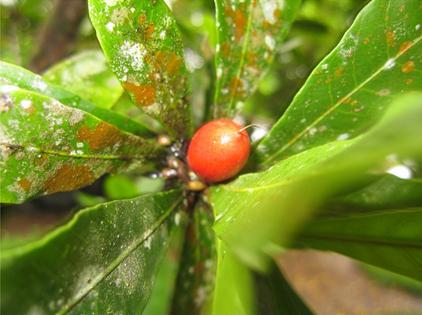
growth
nutrition
The miracle berry (not to be confused with "the miracle tree"), is a photosynthetic autotroph -- it produces its own sugars using energy from sunlight. Sunlight is absorbed via chlorophyll, water is absorbed through the roots, and carbon dioxide is taken in through openings in the leaves called stomata. Through a series of reactions including the carbon dioxide and water, this energy from the sun is converted to chemical energy in the form of sugars.
Other required nutrients, such as phosphorous and nitrogen, are absorbed from the soil through the roots of the plant. A mutualistic relationship with fungi (see interactions section) can enhance this nutrient absorption. Rhizobia bacteria, which can convert atmospheric nitrogen to a form usable by the plant, also form mutualistic relationships with Synsepalum dulcificum.
Synsepalum dulcificum has adapted a multitude of traits to allow it to be successful as a plant. Arguably, the most important of these is the development of vascular tissue. Phloem is used for transport of sugars and xylem is used for transporting water and nutrients throughout the plant. Specialized root systems optimize absorption and specialized leaf structures allow for effective photosynthesis. In addition, all angiosperms have gained the development of flowers to improve pollination success, and seed coats and fruits to protect their seeds.
The development of photoreceptors by many land plants has allowed for the detection of light, and therefore the ability to "move" (if only slightly) towards their source of energy.
In addition, the advancement of various interactions with other organisms (see interactions section below) have allowed this plant to vastly improve its success.
interactions
The miracle berry plant can become infected with many parasites such as spider mites (e.g. Tetranychus ludeni) and mealybugs (e.g. Dysmicoccus brevipes), both of which dessicate the plant. If grown in too damp of conditions, root rot can occur due to infestations of water molds such as Phytophthora cinnamoni and Phytophthora parasitica. The fungus Rigidoporus microporus has also been found to cause root disease on the miracle berry plant.
The plant can beneficially form mycorrhizae (a mutualistic relationship) with fungi of the phylum Glomeromycota in its roots. In this symbiosis, the fungus receives sugars from the plant, while the plant receives vital nutrients such as phosphorous and nitrogen from the fungus. In addition, the nitrogen-fixing Rhizobia bacteria also commonly form mutualistic symbioses with Synsepalum dulcificum; the bacteria convert inaccessible atmospheric nitrogen to ammonia, which is usable by the plant. The plant then provides carbohydrates to the bacteria.
Through photosynthesis, Synsepalum dulcificum contributes to the cycling of oxygen and carbon dioxide in the atmosphere, a vital component to the survival of nearly all other life on earth.
life cycle
Synsepalum dulcificum reproduces sexually via an alternation of generations (other alternation of generation representatives: the white willow, coca plant, and sweet potato plant). The plant rotates between a large, diploid sporophyte life stage and a small, haploid gametophyte stage. From the sporophyte stage, sexual spores are produced via meiosis and mature via mitosis into gametophytes. The gametophyte stage leads to the production of gametes, which fuse via fertilization to form a zygote. Through mitosis, the zygote then matures into the sporophyte.
The flower of the plant contains both the female and male reproductive organs. In order for fertilization to occur, the pollen (male gametophyte) must be transferred to the female gametophyte by pollination. The specific mechanism of Synsepalum dulcificum pollination is unclear, though it is thought that insects, such as the European Honey Bee, may play a role.
MultipleOrganisms.net * UW - La Crosse * Home * About the author
©2012. All Rights Reserved.
home
about the berry
classification
miraculin
references
about the author